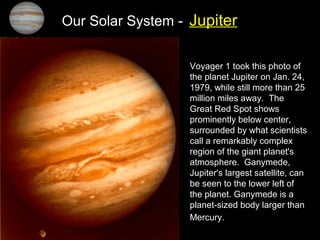
Jupiter
- 1. Our Solar System - Jupiter Voyager 1 took this photo of the planet Jupiter on Jan. 24, 1979, while still more than 25 million miles away. The Great Red Spot shows prominently below center, surrounded by what scientists call a remarkably complex region of the giant planet's atmosphere. Ganymede, Jupiter's largest satellite, can be seen to the lower left of the planet. Ganymede is a planet-sized body larger than Mercury.
- 2. Our Solar System - Jupiter This Voyager 1 picture of the great red spot shows a white oval with its "wake" of counter- rotating vortices. North is at the top and the distance from top to bottom is about 24,000 km.
- 3. Our Solar System - Jupiter Jupiter has a series of rings circling it! Unlike Saturn's rings, which are clearly visible from Earth even through small telescopes, Jupiter's rings are very difficult to see. So difficult, in fact, that they weren't discovered until 1979.
- 4. Our Solar System - Jupiter Europa, one of Jupiter's moons, is one of the most likely places in the Solar System to find life.
- 5. Our Solar System - Jupiter Io was first discovered by Galileo in 1610, making it one of the Galilean Satellites. It is the only moon known to have active volcanism, which is visible on the surface.
- 6. Our Solar System - Jupiter Ganymede is the largest moon of Jupiter and is the largest in our solar system with a diameter of 3,280 miles. If Ganymede orbited the Sun instead of Jupiter it could be classified as a planet. Ganymede is most likely composed of a rocky core with a water/ice mantle and a crust of rock and ice.
- 7. Our Solar System - Jupiter This image shows the heavily cratered surface of Callisto. It was taken by Voyager 2 on July 7, 1979. An enormous impact basin with concentric rings is located near the top and slightly left of center. Callisto is the second largest of Jupiter’s satellites.
- 8. Our Solar System - Jupiter Io, Europa, Ganymede, and Callisto seen in comparison with Earth's moon (far right).
- 9. Our Solar System - Jupiter Jupiter is the supreme god of the Roman pantheon, called dies pater, "shining father". He is a god of light and sky, and protector of the state and its laws.
- 10. Our Solar System - Jupiter Jupiter: Facts and Figures Discovered by: Known by the Ancients Date of Discovery: Unknown Distance from the Sun: 483,682,810 Miles Radius at the Equator: 44,423 Miles Circumference at Equator: 279,118 Miles Number of Known Moons: 63 Length of day: 9 hours and 56 minutes Length of Orbit around Sun: 12 Earth Years
- 11. Our Solar System - Jupiter Jupiter, the fifth planet from the Sun, is more massive than all of the other planets in the solar system combined, plus their satellites, the asteroids and all the comets! Its largest satellite, Ganymede, is larger than the planet Mercury. Each of the four "Galilean Moons," discovered by Galileo in 1610, are larger than the planet Pluto.
- 12. Our Solar System - Jupiter Known as a "gas giant," Jupiter's deep gaseous atmosphere merges imperceptibly into a layer of liquid hydrogen. Within the planet pressure and temperature are so high that there is no clear boundary between the gas and liquid. Jupiter probably has a central core of rocky material about 1.5 times the diameter of Earth and 10 to 15 times more massive. Over this may rest an enormous mantle of liquid metallic hydrogen, which can conduct electrical currents and may be the source of Jupiter's intense magnetic field.
- 13. Our Solar System - Jupiter Jupiter's atmosphere is composed primarily of hydrogen and helium in nearly the same abundances found in the Sun and other stars. Other compounds have also been found, including methane, water, ammonia, acetylene, carbon monoxide and hydrogen cyanide.
- 14. Our Solar System - Jupiter The Great Red Spot is a storm in Jupiter's atmosphere and is at least 300 years old. Winds blow counterclockwise around the Great Red Spot at about 400 kilometers per hour (250 miles per hour). The size of the storm is more than one Earth diameter (13,000 kilometers or 8,000 miles) in the north-south direction and more than two Earth diameters in the east-west direction.
Editor's Notes
- http://nssdc.gsfc.nasa.gov/photo_gallery/photogallery-jupiter.html
- http://nssdc.gsfc.nasa.gov/photo_gallery/photogallery-jupiter.html
- http://www.windows.ucar.edu/tour/link=/jupiter/rings.html
- http://www.windows.ucar.edu/tour/link=/headline_universe/water_europa.html http://www.windows.ucar.edu/tour/link=/headline_universe/space_missions/stories_2003/galileo_demise_sept_2003.html
- http://www.windows.ucar.edu/tour/link=/jupiter/moons/io.html
- http://solarsystem.nasa.gov/planets/profile.cfm?Object=Ganymede
- http://www.solarviews.com/cap/jup/callist1.htm
- http://members.fcac.org/~sol/solcom/stars/jupiter.htm
- http://www.pantheon.org/articles/j/jupiter.html
- http://solarsystem.nasa.gov/planets/profile.cfm?Object=Jupiter
- http://www.planetary.org/learn/solarsystem/jupiter.html
- http://www.planetary.org/learn/solarsystem/jupiter.html
- http://www.planetary.org/learn/solarsystem/jupiter.html
- http://www.planetary.org/learn/solarsystem/jupiter.html